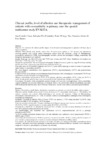| dc.contributor.author | Castaño Carou, Ana Isabel | |
| dc.contributor.author | Pita-Fernández, Salvador | |
| dc.contributor.author | Pértega-Díaz, Sonia | |
| dc.contributor.author | De-Toro, Javier | |
| dc.date.accessioned | 2015-06-09T11:10:43Z | |
| dc.date.issued | 2015-04-16 | |
| dc.identifier.citation | Castaño Carou A, Pita Fernández S, Pértega Díaz S, de Toro Santos FJ. Perfil clínico, grado de afectación y manejo terapéutico de pacientes con artrosis en atención primaria: estudio multicéntrico nacional EVALÚA. Reumatol Clin. 2015 Nov-Dec;11(6):353-360. | es_ES |
| dc.identifier.uri | http://hdl.handle.net/2183/14650 | |
| dc.description.abstract | [Abstract] Objective. To determine the clinical profile, degree of involvement and management in patients with knee, hip or hand osteoarthritis.
Methods. Observational study (health centres from 14 autonomous regions, n = 363 primary care physicians), involving patients with clinical and/or radiological criteria from the American College of Rheumatology, consecutively selected (n = 1258). Sociodemographic variables, clinical and radiological findings, comorbidity and therapeutic management were analysed.
Results. Mean age was 68.0 ± 9.5 years old; 77.8% were women and 47.6% obese. Distribution by location was 84.3% knee, 23.4% hip, and 14.7% hands.
All patients reported pain. The most frequent radiographic Kellgren-Lawrence grade was stage III for knee and hip (42.9% and 51.9%, respectively), and III (37.2%) and II (34.5%) for hip.
Time since onset of osteoarthritis symptoms was 9.4 ± 7.5 years, with a mean age at onset of around 60 years and a family history of osteoarthritis in 66.0%.
The most frequent comorbidities were hypertension (55.1%), depression/anxiety (24.7%) and gastroduodenal diseases (22.9%).
A total of 97.6% of the patients received pharmacological treatment, with oral analgesics (paracetamol) (70.5%) and oral NSAIDs (67.9%) being the most frequent drugs.
Bilateral osteoarthritis was present in 76.9% of the patients with knee osteoarthritis, 59.3% in hip and 94.7% in hands. Female gender and time since onset were associated with bilateral knee and hip osteoarthritis.
Conclusions. The profile of the osteoarthritis patient is female, >65 years old, overweight/obese, with a comorbidity, frequent symptoms and moderate radiologic involvement. Most of the patients had bilateral osteoarthritis, associated with female gender and time since onset of disease. Paracetamol was the most common pharmacological treatment. | es_ES |
| dc.description.abstract | [Resumen] Objetivo. Determinar el perfil clínico, afectación y tratamiento en pacientes con artrosis de rodilla, cadera y manos.
Material y método. Estudio observacional (Centros de Salud de 14 Comunidades Autónomas, n = 363 médicos). Se incluyen pacientes con criterios clínicos/radiológicos de artrosis del American College of Rheumatology, seleccionados consecutivamente (n = 1258). Se analizan variables sociodemográficas, hallazgos clínico-radiológicos, comorbilidad y tratamiento.
Resultados. La media de edad fue 68,0 ± 9,5 años, 77,8% eran mujeres y 47,6% tenían obesidad. Un 84,3% tenían artrosis de rodilla, 23,4% de cadera y 14,7% de manos.
Todos los pacientes referían dolor. El grado radiológico de Kellgren-Lawrence más frecuente en rodilla y mano fue el III (42.9% y 51.9%, respectivamente), y en cadera grado III (37,2%) y II (34,5%).
El tiempo de evolución de los síntomas de artrosis fue 9,4 ± 7,5 años, con edad de inicio alrededor de 60 años. El 66% de los pacientes tenían antecedentes de artrosis.
Las comorbilidades más frecuentes son: hipertensión (55,1%), depresión/ansiedad (24,7%) y patología gastroduodenal (22,9%).
Un 97,6% recibían tratamiento farmacológico, los más utilizados son: analgésicos orales (paracetamol) (70,5%) y AINES orales (67,9%).
Presentaban afectación bilateral el 76,9% de pacientes con artrosis de rodilla, 59,3% en cadera y 94,7% en manos. El sexo femenino y mayor tiempo de evolución se asocian a afectación bilateral en rodilla y cadera.
Conclusiones. El perfil del paciente artrósico es de mujer >65 años, con sobrepeso-obesidad, comorbilidad, clínica frecuente y afectación radiológica moderada. La mayoría presentan afectación bilateral, asociada al sexo femenino y tiempo de evolución. El paracetamol es el fármaco más utilizado. | es_ES |
| dc.language.iso | eng | es_ES |
| dc.publisher | Elsevier | es_ES |
| dc.relation.uri | http://dx.doi.org/doi:10.1016/j.reumae.2015.03.007 | es_ES |
| dc.rights | Creative Commons Attribution-NonCommercial-NoDerivatives 4.0 International License (CC-BY-NC-ND 4.0) | es_ES |
| dc.rights.uri | http://creativecommons.org/licenses/by-nc-nd/4.0/ | |
| dc.subject | Osteoarthritis | es_ES |
| dc.subject | Symptom assessment | es_ES |
| dc.subject | Disease management | es_ES |
| dc.subject | Signs and symptoms | es_ES |
| dc.subject | Osteoartritis | es_ES |
| dc.subject | Evaluación de los síntomas | es_ES |
| dc.subject | Manejo de la enfermedad | es_ES |
| dc.subject | Signos y síntomas | es_ES |
| dc.title | Clinical profile, level of affection and therapeutic management of patients with osteoarthritis in primary care: the spanish multicenter study EVALÚA | es_ES |
| dc.title.alternative | Perfil clínico, grado de afectación y manejo terapéutico de pacientes con artrosis en atención primaria: estudio multicéntrico nacional EVALÚA | es_ES |
| dc.type | info:eu-repo/semantics/article | es_ES |
| dc.rights.access | info:eu-repo/semantics/openAccess | es_ES |
| dc.date.embargoEndDate | 2016-04-16 | es_ES |
| dc.date.embargoLift | 2016-04-16 | |
| UDC.coleccion | Investigación | es_ES |
| UDC.departamento | Fisioterapia, Medicina e Ciencias Biomédicas | es_ES |
| UDC.grupoInv | Grupo de Investigación en Terapia Celular e Medicina Rexenerativa (TCMR) | es_ES |
| UDC.grupoInv | Terapia Celular e Medicina Rexenerativa (INIBIC) | es_ES |
| UDC.institutoCentro | INIBIC - Instituto de Investigacións Biomédicas de A Coruña | es_ES |






